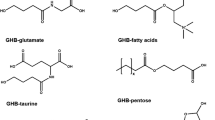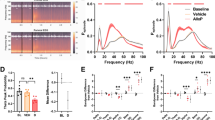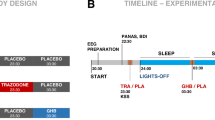Abstract
Although preclinical studies suggest that GHB has low likelihood for abuse, case reports indicate that GHB is abused. This study evaluated the relative abuse liability of GHB in 14 volunteers with histories of drug abuse. Psychomotor, subjective, and cognitive effects of a broad range of GHB doses (2–18?g/70?kg), up to a dose that produced severe behavioral impairment in each participant, were compared to placebo and two abused sedative/hypnotic drugs, triazolam (0.5 and 1?mg/70?kg) and pentobarbital (200 and 400?mg/70?kg), under double-blind, double-dummy conditions at a residential research facility. In general, GHB produced effects similar to triazolam and pentobarbital, although GHB was not identified as a benzodiazepine or barbiturate by participants that correctly identified triazolam and pentobarbital as such. On most measures of likelihood of abuse (eg ratings of liking, reinforcing effects), effects of pentobarbital were significantly greater than those of triazolam, with GHB being intermediate. GHB produced significantly greater negative subjective effects, including nausea, than the other drugs. Memory impairment after GHB was less than that after triazolam and pentobarbital. Within participants, the dose–effect function for sedation was steeper for GHB than for triazolam and pentobarbital. Also, at higher doses, GHB was associated with greater sedation and more variability across participants in sedation. Taken together, these data suggest that the profile of effects of GHB only partially overlaps with that of triazolam and pentobarbital. Although the likelihood for GHB to be abused is intermediate to triazolam and pentobarbital, the possibility of accidental overdose (ie greater sedation than intended) with GHB appears to be greater.
Similar content being viewed by others
Log in or create a free account to read this content
Gain free access to this article, as well as selected content from this journal and more on nature.com
or
References
Addolorato G, Castelli E, Stefanini GF, Casella G, Caputo F, Marsigli L et al (1996). An open multicentric study evaluating 4-hydroxybutyric acid sodium salt in the medium-term treatment of 179 alcohol dependent subjects. GHB Study Group. Alcohol Alcohol 31: 341–345.
Barrett SP, Gross SR, Garand I, Pihl RO (2005). Patterns of simultaneous polysubstance use in Canadian rave attendees. Subst Use Misuse 40: 1525–1537.
Beardsley PM, Balster RL, Harris LS (1996). Evaluation of the discriminative stimulus and reinforcing effects of gammahydroxybutyrate (GHB). Psychopharmacology 127: 315–322.
Beghè F, Carpanini MT (2000). Safey and tolerability of gamma-hydroxybutyrc acid in the treatment of alcohol-dependent patients. Alcohol 20: 223–225.
Bellis MA, Hughes K, Bennett A, Thomson R (2003). The role of an international nightlife resort in the proliferation of recreational drugs. Addiction 98: 1713–1721.
Benavides J, Rumigny JF, Bourguignon JJ, Cash C, Wermuth CG, Mandel P et al (1982). High affinity binding sites for gamma-hydroxybutyric acid in rat brain. Life Sci 30: 953–961.
Borgen LA, Okerholm RA, Lai A, Scharf MB (2004). The pharmacokinetics of sodium oxybate oral solution following acute and chronic administration to narcoleptic patients. J Clin Pharmacol 44: 253–257.
Bosman IJ, Lusthof KJ (2003). Forensic cases involving the use of GHB in The Netherlands. Forensic Sci Int 133: 17–21.
Caldicott DG, Chow FY, Burns BJ, Felgate PD, Byard RW (2004). Fatalities associated with the use of gamma-hydroxybutyrate and its analogues in Australasia. Med J Aust 181: 310–313.
Colombo G, Agabio R, Balaklievskaia N, Diaz G, Lobina C, Reali R et al (1995). Oral self-administration of gamma-hydroxybutyric acid in the rat. Eur J Pharmacol 285: 103–107.
Colombo G, Agabio R, Diaz G, Fa M, Lobina C, Reali R et al (1998). Gamma-hydroxybutyric acid intake in ethanol-preferring sP and nonpreferring sNP rats. Physiol Behav 64: 197–202.
Couper FJ, Thatcher JE, Logan BK (2004). Suspected GHB overdoses in the emergency department. J Anal Toxicol 28: 481–484.
Degenhardt L, Copeland J, Dillon P (2005). Recent trends in the use of ‘club drugs’: an Australian review. Subst Use Misuse 40: 1241–1256.
Degenhardt L, Darke S, Dillon P (2002). GHB use among Australians: characteristics, use patterns and associated harm. Drug Alcohol Depend 67: 89–94.
Degenhardt L, Darke S, Dillon P (2003). The prevalence and correlates of gamma-hydroxybutyrate (GHB) overdose among Australian users. Addiction 98: 199–204.
Fattore L, Cossu G, Martellotta C, Deiana S, Fratta W (2001). Baclofen antagonises intravenous self-administration of γ-hydroxybutyric acid in mice. Neuroreport 12: 2243–2246.
Ferrara SD, Giorgetti R, Zancaner S, Orlando R, Tagliabracci A, Cavarzeran F et al (1999). Effects of single dose gamma-hydroxybutyric acid and lorazepam on psychomotor performance and subjective feelings in healthy volunteers. Eur J Clin Pharmacol 54: 821–827.
Freese TE, Miotto K, Reback CJ (2002). The effects and consequences of selected club drugs. J Subst Abuse Treat 23: 151–156.
Fuller DE, Hornfeldt CS (2003). From club drug to orphan drug: sodium oxybate (Xyrem) for the treatment of cataplexy. Pharmacotherapy 23: 1205–1209.
Galloway GP, Frederick SL, Staggers FE, Gonzales M, Stalcup SA, Smith DE (1997). Gamma-hydroxybutyrate: an emerging drug of abuse that causes physical dependence. Addiction 92: 89–96.
Gonzalez A, Nutt DJ (2005). Gamma hydroxy butyrate abuse and dependency. J Psychopharmacol 19: 195–204.
Griffiths RR, Bigelow GE, Ator NA (2003). Principles of initial experimental drug abuse liability assessment in humans. Drug Alcohol Depend 70: S41–S54.
Griffiths RR, Bigelow GE, Liebson I (1983). Differential effects of diazepam and pentobarbital on mood and behavior. Arch Gen Psychiatry 40: 865–873.
Griffiths RR, Bigelow GE, Liebson I, Kaliszak JE (1980). Drug preference in humans: double-blind choice comparison of pentobarbital, diazepam and placebo. J Pharmacol Exp Ther 215: 649–661.
Griffiths RR, Johnson MW (2005). Relative abuse liability of hypnotic drugs: a conceptual framework and algorithm for differentiating among compounds. J Clin Psychiatry 9: 31–41.
Griffiths RR, Lamb RJ, Ator NA, Roache JD, Brady JV (1985). Relative abuse liability of triazolam: experimental assessment in animals and humans. Neurosci Biobehav Rev 9: 133–151.
Griffiths RR, Lukas SE, Bradford LD, Brady JV, Snell JD (1981). Self-injection of barbiturates and benzodiazepines in baboons. Psychopharmacology 75: 101–109.
Griffiths RR, Troisi JR, Silverman K, Mumford GK (1993). Multiple-choice procedure: an efficient approach for investigating drug reinforcement in humans. Behav Pharmacol 4: 3–13.
Grove-White IG, Kelman GR (1971). Effect of methohexitone, diazepam and sodium 4-hydroxybutyrate on short-term memory. Br J Anaesth 43: 113–116.
Itzhak Y, Ali SF (2002). Repeated administration of gamma-hydroxybutyric acid (GHB) to mice: assessment of the sedative and rewarding effects of GHB. Ann NY Acad Sci 965: 451–460.
Kintz P, Villain M, Pélissier A, Cirimele V, Leonetti G (2005). Unusually high concentrations in a fatal GHB case. J Anal Toxicol 29: 582–585.
Liechti ME, Kunz I, Greminger P, Speich R, Kupferschmidt H (2006). Clinical features of gamma-hydroxybutyrate and gamma-butyrolactone toxicity and concomitant drug and alcohol use. Drug Alcohol Depend 81: 323–326.
Maitre M (1997). The ã-hydroxybutyrate signaling system in brain: organization and functional implications. Prog Neurobiol 51: 337–361.
Martellotta MC, Cossu G, Fattore L, Gessa GL, Fratta W (1998). Intravenous self-administration of gamma-hydroxybutyric acid in drug-naïve mice. Eur Neuropsychopharmacology 8: 293–296.
Martellotta MC, Fattore L, Cossu G, Fratta W (1997). Rewarding properties of gamma-hydroxybutyric acid: an evaluation through place preference paradigm. Psychopharmacology 132: 1–5.
Mathivet P, Bernasconi R, De Barry J, Marescaux C, Bittiger H (1997). Binding characteristics of γ-hydroxybutyric acid as a weak but selective GABAB receptor agonist. Eur J Pharmacol 321: 67–75.
McLeod D, Griffiths RR, Bigelow GE, Yingling J (1982). An automated version of the digit symbol substitution test (DSST). Behav Res Methods Instrum 14: 463–466.
Metcalf DR, Emde RN, Stripe JT (1966). An EEG-behavioral study of sodium hydroxybutyrate in humans. Electroenceph Clin Neurophysiol 20: 506–512.
Mintzer MZ, Griffiths RR (1998). Flunitrazepam and triazolam: a comparison of behavioral effects and abuse liability. Drug Alcohol Depend 53: 49–66.
Mintzer MZ, Griffiths RR (2005). An abuse liability comparison of flunitrazepam and triazolam in sedative drug abusers. Behav Pharmacol 16: 579–584.
Mintzer MZ, Guarino J, Kirk T, Roache JD, Griffiths RR (1997). Ethanol and pentobarbital: comparison of behavioral and subjective effects in sedative drug abusers. Exp Clin Psychopharmacol 5: 203–215.
Miotto K, Darakjian J, Basch J, Murray S, Zogg J, Rawson R (2001). Gamma-hydroxybutyric acid: patterns of use, effects and withdrawal. Am J Addict 10: 232–241.
Mumford GK, Rush CR, Griffiths RR (1995). Abecarnil and alprazolam in humans: behavioral, subjective and reinforcing effects. J Pharmacol Exp Ther 272: 570–580.
Nicholson KL, Balster RL (2001). GHB: a new and novel drug of abuse. Drug Alcohol Depend 63: 1–22.
Poldrugo F, Addolorato G (1999). The role of γ-hydroxybutyric acid in the treatment of alcoholism: from animal to clinical studies. Alcohol Alcohol 34: 15–24.
Roache JD, Griffiths RR (1985). Comparison of triazolam and pentobarbital: performance impairment, subjective effects and abuse liability. J Pharmacol Exp Ther 234: 120–133.
Roache JD, Griffiths RR (1987). Lorazepam and meprobamate dose effects in humans: behavioral effects and abuse liability. J Pharmacol Exp Ther 243: 978–988.
Romanelli F, Smith KM, Pomeroy C (2003). Use of club drugs by HIV-seropositive and HIV-seronegative gay and bisexual men. Top HIV Med 11: 25–32.
Rosen MI, Pearsall HR, Woods SW, Kosten TR (1997). Effects of gamma-hydroxybutyric acid (GHB) in opioid-dependent patients. J Subst Abuse Treat 14: 149–154.
Rush CR, Frey JM, Griffiths RR (1999). Zaleplon and triazolam in humans: acute behavioral effects and abuse potential. Psychopharmacology 145: 39–51.
Schwartz RH, Milteer R, LeBeau MA (2000). Drug facilitated sexual assault (‘date rape’). South Med J 93: 558–561.
Snodgrass JG, Corwin J (1988). Pragmatics of measuring recognition memory: applications to dementia and amnesia. J Exp Psychcol Gen 117: 34–50.
Varela M, Nogue S, Oros M, Miro O (2004). Gamma hydroxybutyrate use for sexual assault. Emerg Med J 21: 255–256.
Wechsler D (1958). The Measurement and Appraisal of Adult Intelligence. Williams & Wilkins: Baltimore, MD.
Woolverton WL, Rowlett JK, Winger G, Woods JH, Gerak LR, France CP (1999). Evaluation of the reinforcing and discriminative stimulus effects of γ-hydroxybutyrate in rhesus monkeys. Drug Alcohol Depend 54: 137–143.
Zawertailo LA, Busto UE, Kaplan HL, Greenblatt DJ, Sellers EM (2003). Comparative abuse liability and pharmacological effects of meprobamate, triazolam, and butabarbital. J Clin Psychopharmacol 23: 269–280.
Zvosec DL, Smith SW, McCutcheon JR, Spillane J, Hall BJ, Peacock EA (2001). Adverse events, including death, associated with the use of 1,4-butanediol. N Engl J Med 344: 87–94.
Acknowledgements
We would like to thank Kristina Burns, Linda Felch, Paul Nuzzo, and John Yingling for excellent technical assistance. We also thank Matthew Johnson for helpful discussion and editorial comments. This research was supported by the National Institute on Drug Abuse Grant R01 DA003889 (RRG) and an unrestricted grant from Orphan Medical Inc. (now known as Jazz Pharmaceuticals). GHB and GHB placebo solutions were generously provided by Orphan Medical; Minnetonka, MN, now known as Jazz Pharmaceuticals, Palo Alto, CA.
Author information
Authors and Affiliations
Corresponding author
Rights and permissions
About this article
Cite this article
Carter, L., Richards, B., Mintzer, M. et al. Relative Abuse Liability of GHB in Humans: A Comparison of Psychomotor, Subjective, and Cognitive Effects of Supratherapeutic Doses of Triazolam, Pentobarbital, and GHB. Neuropsychopharmacol 31, 2537–2551 (2006). https://doi.org/10.1038/sj.npp.1301146
Received:
Revised:
Accepted:
Published:
Issue date:
DOI: https://doi.org/10.1038/sj.npp.1301146
Keywords
This article is cited by
-
An Update on the Misuse and Abuse Potential of Pharmacological Treatments for Central Disorders of Hypersomnolence
Current Sleep Medicine Reports (2022)
-
Double-blind comparison of the two hallucinogens psilocybin and dextromethorphan: similarities and differences in subjective experiences
Psychopharmacology (2018)
-
Double-blind comparison of the two hallucinogens psilocybin and dextromethorphan: effects on cognition
Psychopharmacology (2018)
-
Effect of γ-hydroxybutyrate (GHB) on driving as measured by a driving simulator
Psychopharmacology (2018)



